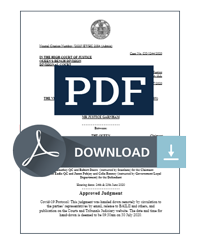Sentencing - An Update
The Sentencing Code 2020
This summary seeks to provide some key pointers as to how to approach the Sentencing Code as well as reflecting briefly on some other key guidelines which have recently been introduced by the Sentencing Council. Marie Spenwyn is a criminal defence practitioner of over twenty years experience defending in cases of the utmost severity. She is also a Visiting Lecturer with the University of Law and an advocacy trainer. Along with Dr Bradley Hiller Consultant Forensic Psychiatrist she recently presented an update for Libertas Chambers focusing on the guideline for sentencing offenders with mental disorders.
Codification is often seen as a concept outwith this jurisdiction. If that is right then the approach taken to codify – and label as such – sentencing powers and provisions in the Sentencing Code 2020 is a brave move. Brave or not it is in my view an incredibly useful development which will aid practitioners grappling often with multiple pieces of legislation which found provisions that could come into play in mitigation even for a single offence. If we take an example of a sentence for an offence where credit for plea is relevant but also where a minimum sentence applies, where there are sentencing guidelines, where there is a qualifying tag leading to the need for days to be credited, where there may be disqualification which could apply we are looking at a number of pieces of separate legislation. If the case concerns a young person you can immediately increase the sources of provisions for both these key features before you begin to look at the multiple sources for potential sentencing outcomes.
The Sentencing Code deals with the procedural aspects of sentencing and not sentencing powers themselves – it remains the position that maximum sentences for offences come from the separate pieces of legislation creating offences. Helpfully the code looks at the procedure for sentencing from a logical point of view – which gives assistance to the less experienced advocate in terms of where to find things and also what amount to a ‘checklist’ of what to consider. The Sentencing Act 2020 which brings it into force anticipates that further additions to or amendments of sentencing provisions are inserted so that it is a ‘living’ piece of legislation.
The SC applies to all sentences after the 1st December 2020 regardless of date of commission of the offence(s). As noted above it does not affect in any way maximum sentences more it is the source of overarching framework for sentencing. It is useful to be able to immediately locate the provisions for what the maximum credit available when a plea is entered to a third strike offence without flicking through a textbook under the offence only to be referred to the ‘sentencing chapter’ and the convoluted sections on minimum sentences. As an example when dealing with a third strike drug offence you can now go to the chapter three for mitigating features – section 73 dealing with guilty pleas, and to the minimum sentences in chapter seven, specifically s311 for this offence. Of further note helpfully Schedule 21 (determination of minimum terms for mandatory life sentences) appears in the schedules to the SC as…Schedule 21!
The Sentencing Code (SC) does not include the source of every single aspect that might be relevant in a sentencing exercise but what it does do – with a logical, structured approach – is provide a guide to where to start. It is designed to work in conjunction with the Sentencing Council Guidelines and the Criminal Procedure Rules as well as the Criminal Practice Directions. Under Section 59 of the SC the general duty of court as to use of guidelines is clearly set out – this affirms the importance of the advocate being familiar with sentencing guidelines and using them in sentencing exercises. For a useful view on the SC from David Ormerod see link – https://www.sentencingcouncil.org.uk/wp-content/uploads/The-Sentencing-Code-10-things-to-know-revised-1.pdf
Speaking of sentencing guidelines, on the 1st October 2020 a new overarching guideline came into force focusing on the approach to sentencing those who have mental disorders, neurological impairment or developmental disorders. The majority of offence specific guidelines refer in the mitigating features ‘boxes’ to whether there are any features of the case peculiar to the offender as to mental disorders but without any real assistance as to how reference can properly be made during mitigation to exactly what the resulting impact on determining sentence should be. This guideline is important for anyone representing those with any condition which can be included in the broad categories the guideline utilises. It provides support for a plea in mitigation that properly should encompass a real focus on those elements and their relevance to often both offence and offender. As is often the case the guideline may be most useful when focusing on the difference between community disposals or suspended sentences as being appropriate alternatives to immediate custody.
The new firearms guideline applies as of the 1st January 2021. All practitioners will know that dealing with firearms cases has flung us back on R v Avis and the key points therein, but without the more specific assistance that is now common-place in many other areas with offence specific guidelines. The new guideline will therefore be welcome to some though it remains to be seen quite how it will be applied. It is also an area where the Sentencing Code and the interplay with the guidelines should be of some use – as noted above locating the source of minimum provisions which apply to some firearms should be more straightforward [Sentencing Code at s311].
It is a busy time for sentencing updates and reviews. On the 21st January 2021 the Sentencing Council published a ‘new’ sentencing guideline which impacts upon drugs offences. Practitioners should be alert to where these changes will alter the now familiar categorisations from the 2012 guidelines that apply to the key drug offences under the broad umbrella of importation, production and supply offences. The new guidelines come into force on the 1st April 2021. The focus of the revised guidelines is largely two-fold – firstly seeking to provide more assistance as to the recognition of how frequently vulnerable people are exploited within the spectrum of drugs offences and updating as to the types of drugs vis a vis ‘new drugs’ such as Spice and synthetic drugs, as well as changes in the potential yield and purity of some drugs with the consequential impact on the assessment of harm.
There is more to come; a consultation is underway focusing on sentencing modern slavery offences, draft guidelines have been published for trade mark offences. Watch this space for further updates.


